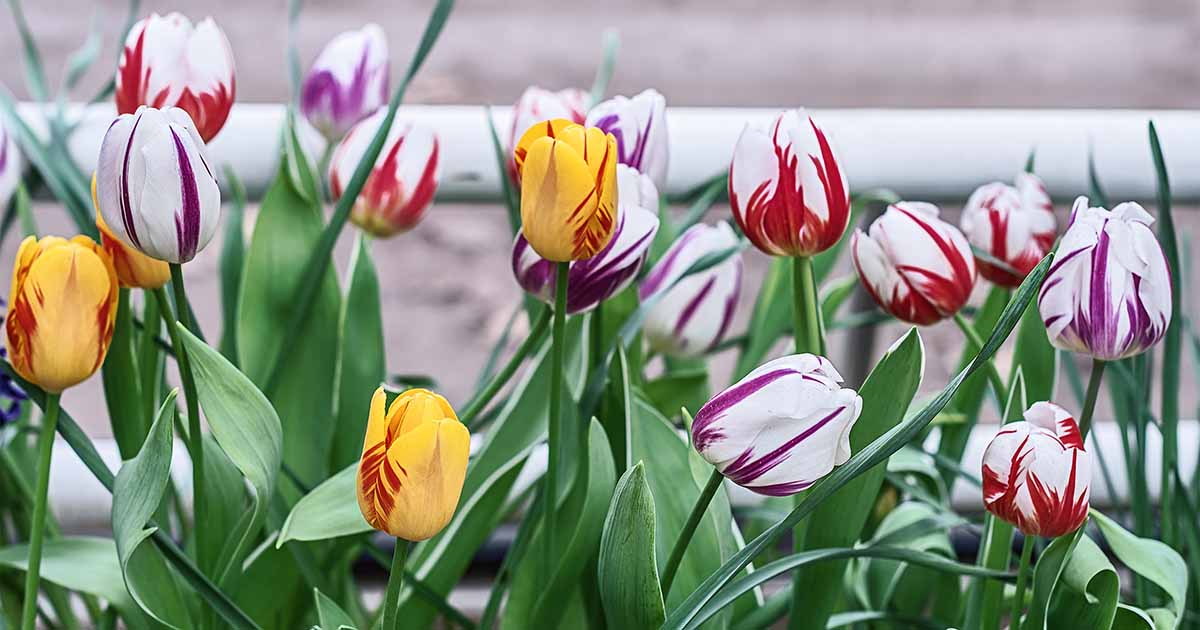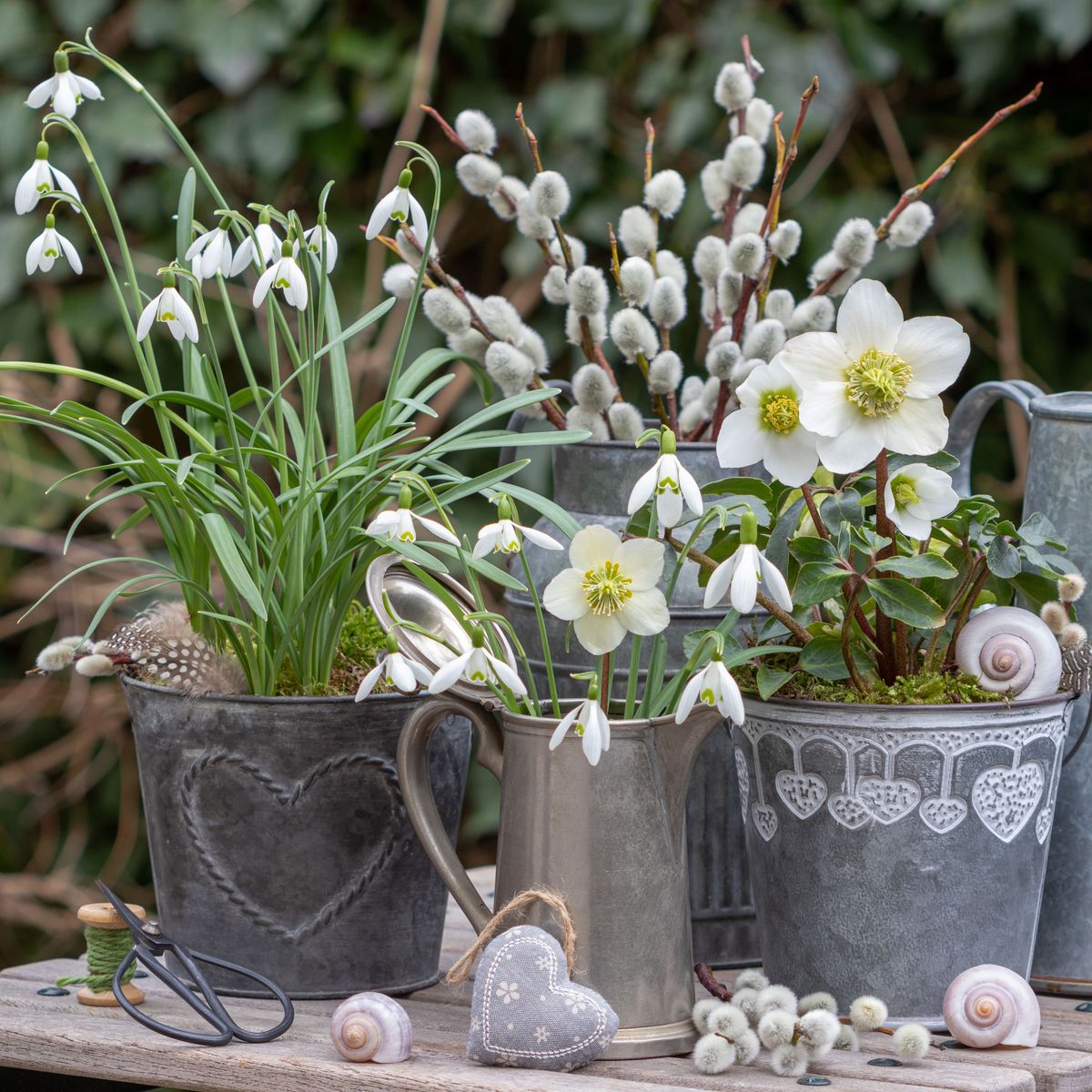Tulipa x
Rembrandt tulips are literally the stuff of legend.
They represent some of the most expensive flowers ever sold, and their story involves the collapse of a major economy, a starring role in classic art, and a mysterious virus that both created and threatened their very existence.

We link to vendors to help you find relevant products. If you buy from one of our links, we may earn a commission.
Today’s Rembrandts have ditched the drama and delicate constitution but kept the spectacular appearance that prompted so much fuss.
Tulips are easy to love with their carefree nature, but these particular types are exceptionally lovely.
The flame-like markings stand out, making a striking display, especially when you cluster them in a big group.
Whether you’re familiar with growing Tulipa plants already and you just want to know more about Rembrandts, or you’re new to the genus altogether, we’ll help you make the most of them with this guide.
Here’s everything we’ll discuss, coming right up:
These gorgeous flowers have a fascinating history, and the modern types are downright easy to grow.
If you live in USDA Zone 7 or below, growing Rembrandts is a piece of cake. You can do it in Zones 8 and above, too – we’ll let you in on the secret to cultivation in warmer regions in just a bit.
Cultivation and History
Rembrandts are part of the Triumph group of tulips, Division 9, which is the largest group of plants in the Tulipa genus.
They all have single blossoms and strong stems, perfect for cutting.
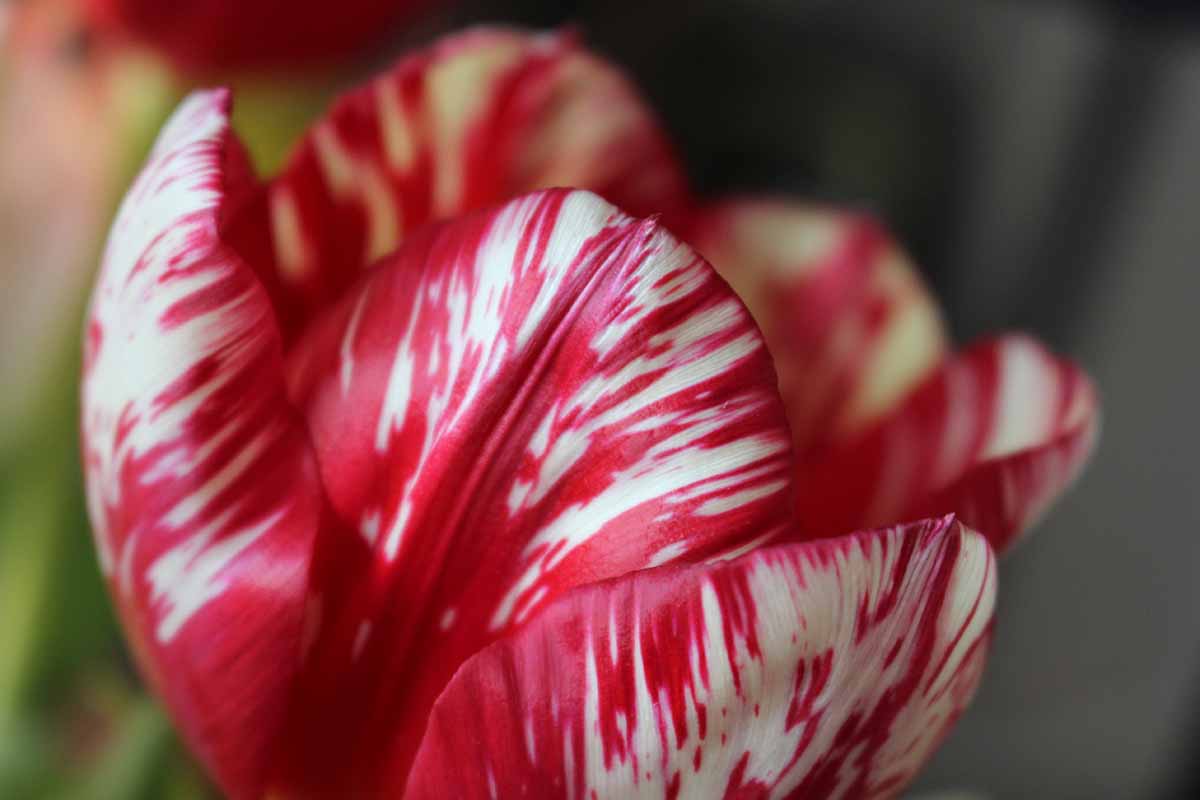
Rembrandts are named for the Dutch painter Rembrandt Harmenszoon van Rijn, though he wasn’t really known for painting tulips and they weren’t called that when they were first bred by horticulturists.
There’s just one prominent painting of his, called “Saskia as Flora,” that features a red and white tulip in the floral crown of his wife, Saskia van Uylenburgh.
There are two categories of these flowers: Rembrandts and improved Rembrandts. That’s just a fancy way of saying that there are older ones as well as modern hybrids.
To understand the difference, we need to dive into a little bit of history. Plant nerds, get ready for some fun!
Most of us have heard about “tulipmania,” aka “tulpenmanie” in Dutch. For about three years starting in 1634, people in Holland were frantic to obtain the latest, greatest tulips.
To set the stage, the Dutch were some of the wealthiest people on the planet at the time, and when you have a lot of money, you have to find new ways to use and display all that wealth.

Today, that might be with increasingly massive yachts or jewels, but the Dutch turned to speculating on tulips.
Collectors spent unmentionable sums to buy new and interesting tulip plants. To be clear, they didn’t buy physical plants, they were buying the right to multicolored, unique beauties promised by growers.
These variations were caused by mosaic virus, also known as the tulip breaking virus.
This disease spread by aphids causes beautiful and interesting variations in petal color and pattern by suppressing the pigment in the petals.
Even though it produces some really cool effects, you don’t want to rely on a virus method of propagation. It’s not predictable, though offsets do grow true. But it causes slower, weaker growth, which isn’t a recipe for future success.
Some of the most famous, expensive, and beautiful Rembrandts are lost to time because they were weak.
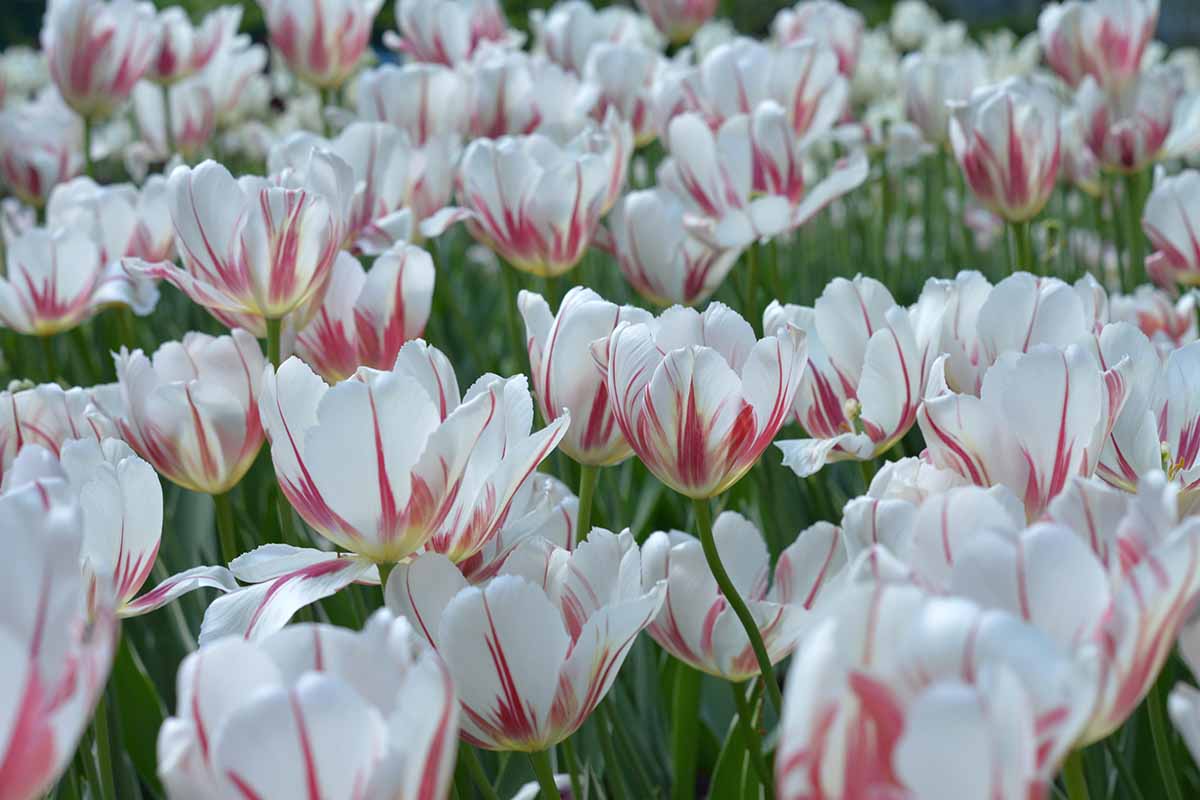
The revered ‘Semper Augustus’ is one example of a beloved, ridiculously expensive variety that faded out of production because it was too weak and sickly to continue in breeding programs.
But the fiery red and white striped petals are still the standard for what breeders hope to achieve.
The deeper red and white ‘Admirael van Enkhuizen’ is another.
It was the most expensive tulip confirmed to have been sold at the time, in 1637 at the Alkmaar auction just before the collapse of the tulip market. It also failed to be vigorous enough to continue in breeding programs.
Some from this time, like the rose red and white ‘Zomerschoon,’ are still around.
People bought up plants that showed interesting growth, and even your “average” tulip without the virus became more valuable.
This type of speculative trading produced what some people consider to be the origin of the modern financial market. Stocks and bonds? You can partially thank tulipmania for that.
When the tulip market crashed after people realized that future tulips they’d paid for might not come to fruition, it caused a depression in the European economy. Suddenly, no one wanted these famous flowers anymore.
By the 1960s, scientists determined that these unique tulips were caused by a virus, but growers realized long ago that these flowers weren’t healthy, and they were culled from many gardens.
It’s illegal to sell them in Holland without a special permit, even today.
But during the peak of their fame, breeders attempted to encourage the dramatic coloring using all kinds of questionable techniques, since no one understood what kind of magic or alchemy was causing the unique coloration.
Though we tend to think of ourselves as smarter than that in modern times, this kind of spending “mania” exists with modern plants as well, but usually on a smaller scale.
For instance, the rush for variegated monsteras raged and rapidly cooled, with cuttings commanding incredible prices that diminished to much more reasonable sums in just a few years.
Anyway, modern Rembrandts aren’t bred using plants infected with mosaic virus.
These improved tulips have been bred to look like the virus-infected types but without the presence of the disease, which causes much slower growth and is unpredictable.
Today, almost all Rembrandts are the improved type. You really have to go out of your way to hunt down the original types, which are sometimes called broken, historic, or heirloom Rembrandts.
Propagation
Tulips of all types need rich, well-draining soil.
If you have heavy clay, consider planting in containers or raised beds, or amending your soil with a ton of well-rotted compost, regardless of which propagation method you use.
From Bulbs
Bulbs are usually available at stores in the fall for planting right away.
Plant the bulbs six inches apart and deep enough that each bulb is covered with three inches of soil. Water the soil well.
From Divisions
Once the leaves have died back in the summer, but before you pull the leaves, dig down and pull up the clumps of bulbs.
Separate them into individual bulbs and replant as described above.
How to Grow
Tulips are thirsty, but only sometimes. They like their soil to be moist in the fall, winter, and spring. But too much moisture in the summer will shorten their lives dramatically.
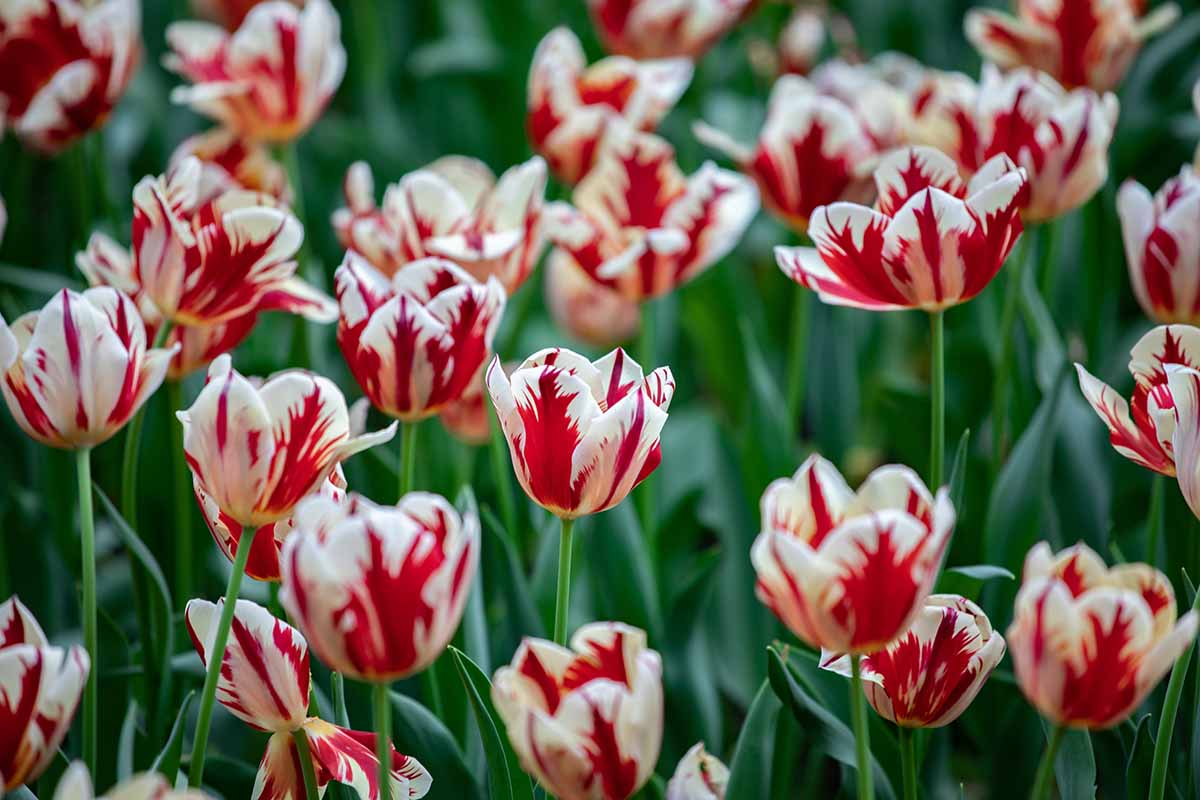
Remember, tulips are native to Kazakhstan, which has hot, dry summers, and these plants are dormant in the summer.
Let the soil dry out before watering during the summertime. Throughout the rest of the year, add water when the top inch or so dries out.
If you adore tulips but you live in Zone 8 or up, you’ll need to dig those bulbs up in the fall and chill them in the refrigerator for eight weeks. Then, you can put them back in the ground.
In the summer, when the blossoms fade and the leaves start to turn yellow, it’s time to fertilize with a 10-10-10 NPK fertilizer.
Regardless of where you live, if you want to go the extra mile and extend their lifespan, dig up the bulbs and store them in a basement or somewhere else cool and dark.
Replant them in the fall, a month before the predicted first frost, after the soil has cooled off from the summer heat.
While they’re out of the garden, you can place some fun annuals in their former location to add some color.
If your plants seem to fade after a few years, don’t feel too bad. It wasn’t something you did.
It’s just the nature of tulips, and it’s why many people grow them as annuals. Just pull any plants that start to look a little sad and replace them with new bulbs.
Growing Tips
- Reduce watering in the summer.
- Fertilize in the summer after blooming.
- Replace faded plants after a few years.
Maintenance
Feel free to cut off the stem after each flower has faded, but don’t trim away the leaves just yet.
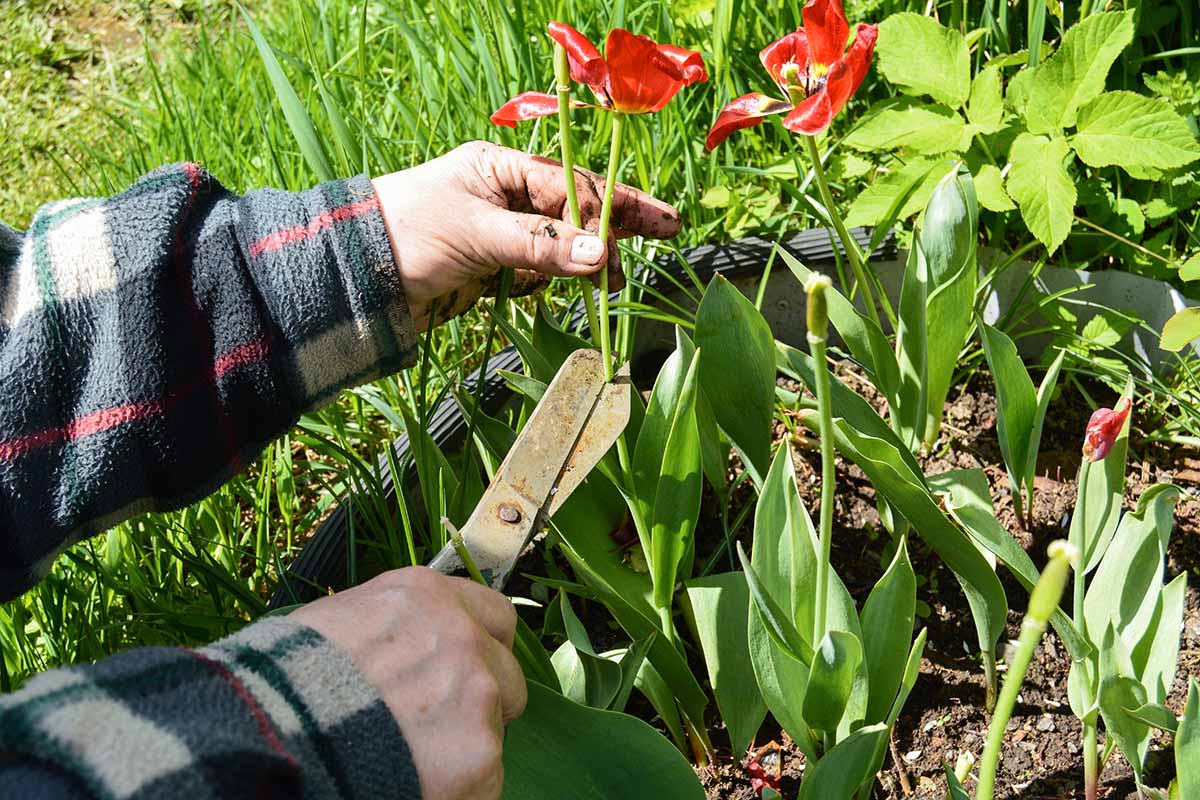
If you want your flowers to return year after year with blossoms that are as big and abundant as ever, let the leaves turn completely yellow and then brown before cutting them or pulling them.
If you go to pull a dead leaf, it should come away from the plant cleanly and easily. If you have to tug at all, don’t take it just yet.
Cultivars to Select
In keeping with the original categorization, there are three color groups for Rembrandts and their improved counterparts.
- Bijbloemens have purple flames or stripes on a white base.
- Bizarres have a red or yellow base with brown flames and stripes.
- Roses have a white base with pink or red coloration.
Feather coloration describes faint markings on flowers in any of the three color groups, and flame coloration describes bolder, richer markings.
I don’t recommend planting heirloom Rembrandts unless you’re extraordinarily careful.
The mosaic disease is highly contagious, and you don’t want to be responsible for spreading a disease that will weaken your or your neighbor’s prize tulips.
Stick with improved options if you just want to enjoy these beauties that are so easy to care for.

Rembrandt Mix
If you can’t pick just one color, go for a mix. You can find mixed packages of bulbs in various colors at many gardening stores, including Eden Brothers and Dutch Grown.
Carnaval de Rio
With bright red flames on a white base, these rose-type single flowers are as beautifully colored as any of the heirloom types, only you won’t have to fuss with virus-laden tulips.
As they mature, some will show subtle hints of yellow among the red, making them stand out even more.

‘Carnaval de Rio’
Start the party in your garden by grabbing packs of 10 bulbs at Burpee.
Grand Perfection
These tulips are – wait for it – modern Rembrandt perfection.
Young petals on this rose type start out creamy yellow with red flames before maturing to maroon stripes on a white base.
They’ll fill your garden with flowers that look like they’ve been painted in brushstrokes by the grand masters.

‘Grand Perfection’
Pick up packages of 15 bulbs at Home Depot.
Helmar
‘Helmar’ is one of my favorites of all the modern Rembrandts.
It’s a bizarre type with extremely bold flame-like stripes that appear to have been painted on by the brush of an artist that favors the brightest colors possible.
At 18 inches tall, it reaches high above some of the shorter cultivars. Paired with the intense color, this makes it a stand-out flower for your garden.
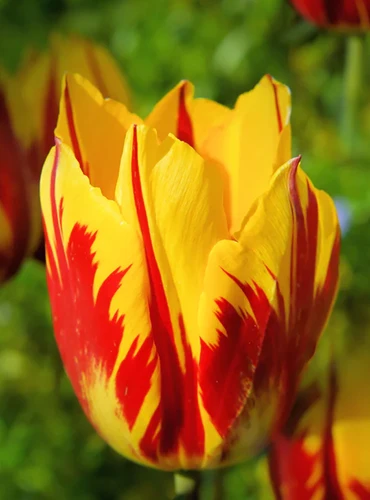
‘Helmar’
If you want to dip your toes into the Rembrandt world, you’d be smart to go with this one. It lives a long time and the plants are extremely tough.
Dutch Grown carries this exceptional option.
Insulinde
While it was only first cultivated about 100 years ago, ‘Insulinde’ is a Bijbloemens with the classic look of the original Rembrandts and is the result of the same virus that created all those gorgeous flowers that caused so much financial ruin centuries ago.

It has swirls, whirls, and streaks of reddish-purple on a petite flower.
Remember, this one is infected with a virus, so it’s best grown indoors, in a greenhouse, or otherwise isolated from other tulips.
But if you’d like to experiment with growing the original broken tulips, this is one of the few still in cultivation, and it’s awfully beautiful.
Divide it often because the plants tend to become smaller and weaker as they age.
Mickey Mouse
With its classic bizarre coloring in bright yellow and flaming red, ‘Mickey Mouse’ flowers earlier than other Rembrandts, with bold, single blossoms.
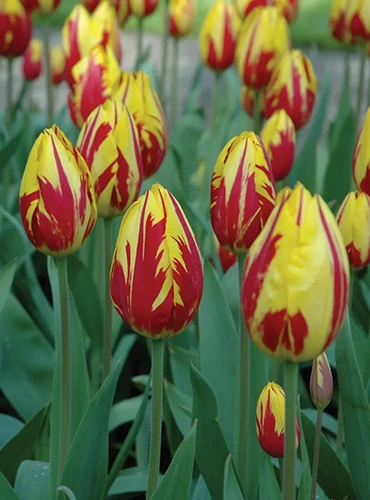
‘Mickey Mouse’
Snag packages of 10 bulbs for your garden at Burpee.
Rem’s Favorite
I don’t know if Rembrandt would consider this his favorite tulip, but you can easily imagine it gracing a painting by one of the Dutch masters and pulling in the big bucks in tulipmania times.
Technically a rose type, the flaming stripes are darker purple than that of many other cultivars.
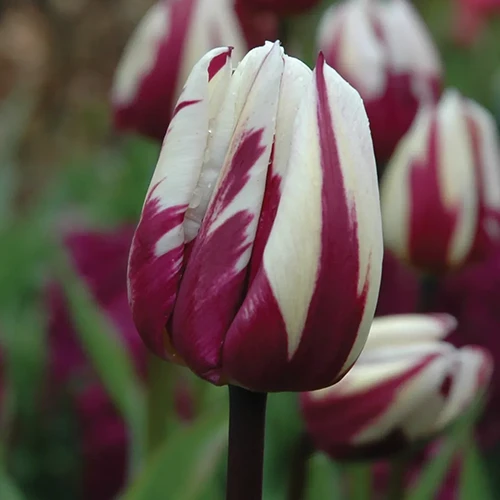
‘Rem’s Favorite’
Even if Rembrandt had other favorites, this is one of mine. Bring it to your home by snagging a pack of 10 bulbs from Burpee.
Managing Pests and Disease
Rembrandts are no different than other types of tulips when it comes to the kinds of problems that can bother these plants. In particular, I find that deer, rabbits, and voles seem to really like them.
Remember, the historic types are weaker than modern types, so they’re even more susceptible to problems and predators.
Herbivores
So… I have some really bad news for you. Herbivores love tulips, both the bulbs and the leaves.
They love them so much that I’m tempted to take a bite of my bulbs just to see what all the fuss is about.
By the way, tulips are edible, and people in Europe turned to eating them during the food shortages of World War II.
But too much can give you indigestion thanks to the glycoside the plant contains, tuliposide A and tulipalin A.
Stick with nibbling on the flower petals if you want to give yours a try, which taste better and won’t make you sick.
You’ll get uncomfortably full before you can eat enough petals to send you running to the restroom.
That aside, here’s how to deal with the competition looking to eat your plants before you can enjoy them.
Deer
You get up in the morning and head out to your garden to find that your tulip plants have been mowed down like someone just ran over your garden with a lawnmower.
But you know you weren’t out there in the middle of the night doing lawn maintenance.
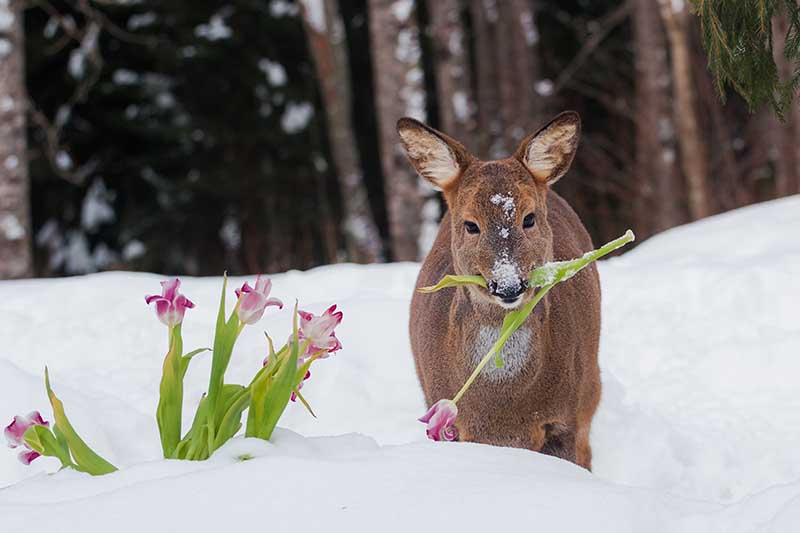
It’s probably deer, or maybe elk.
Read our guide to dealing with deer for more information on how to drive these hungry ungulates from your garden.
Rabbits
Rabbits will nibble on tulip bulbs, leaves, and flowers. They’re hungry, and they reproduce so quickly that they’re truly worthy of their own cliche.
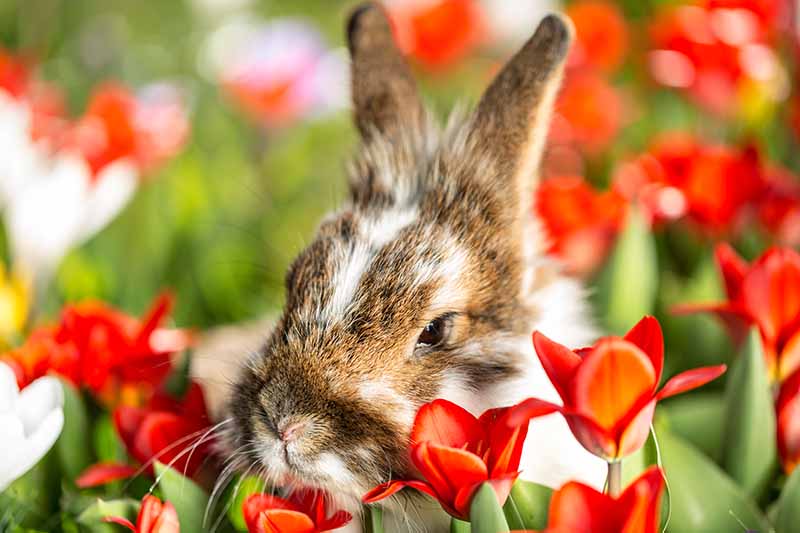
If something is eating the stems and leaves, as well as digging into the bulbs, it’s probably rabbits. Deer just mow the leaves down like a lawnmower.
If it seems like rabbits are the problem, we have a guide to walk you through the process of dealing with them.
Voles
People often confuse moles and voles. Moles are carnivores. If something is eating your bulbs underground, it’s probably voles.
Voles are hard to control, and if you regularly find them in your garden, you might as well give up your tulip dreams, since they seem to adore these plants.
Okay, it’s not that bad, but you definitely have a battle ahead.
If you aren’t ready to wave the white flag, either plant in raised beds lined with chicken wire or try containers.
Traps and repellents can also help, but keep in mind that these animals reproduce rapidly, and they’ll go for tulips straight away.
Insects and Disease
Rembrandts are susceptible to every pest and disease that impacts other types. Our general guide to growing tulips provides all the info you’ll need.
Best Uses
During the heyday of tulipmania, it was all about a single specimen displayed on its own.
These days, we grow them in big, massive groups to make more of an impact. Combine multiple colors or just focus on one to make a big showing.

Tulips work well in borders, mass plantings, and containers.
They’re beautiful combined with plants that will fill the area before they bloom and after they fade. Think crocuses, daylilies, lilies, grasses, ornamental alliums, and snapdragons.
And, of course, you can use them in cut flower displays.
Quick Reference Growing Guide
| Plant Type: | Perennial flowering bulb | Flower / Foliage Color: | Brown, pink, red, white, yellow/green |
| Native to: | Modern Kazakhstan and other parts of Central Asia | Water Needs: | Moderate |
| Hardiness (USDA Zone): | 3-10 | Maintenance: | Low |
| Bloom Time / Season: | Spring | Tolerance: | Summer drought |
| Time to Maturity: | Up to 3 years (bulblets) | Soil Type: | Loamy, loose |
| Exposure: | Full to part sun | Soil pH: | 6.0-6.5 |
| Spacing: | 6 inches | Soil Drainage: | Well-draining |
| Planting Depth: | 3 inches | Companion Planting: | Crocuses, daylilies, lilies, grasses, ornamental alliums, snapdragons |
| Height: | Up to 2 feet | Uses: | Mass planting, borders, containers |
| Spread: | 6 inches | Order: | Liliales |
| Growth Rate: | Fast | Family: | Liliaceae |
| Common Pests and Diseases: | Aphids, bulb mites, deer, rabbits, slugs, snails, spider mites, voles, wireworms; basal rot, botrytis blight, tulip breaking virus, tulip crown rot | Genus: | Tulipa |
A Tulip Worthy of All the Drama
While it’s easy to see why people were infected with the tulip virus during the mania, thank goodness modern breeders have figured out how to create all the drama of the Rembrandt tulip without all the… drama.
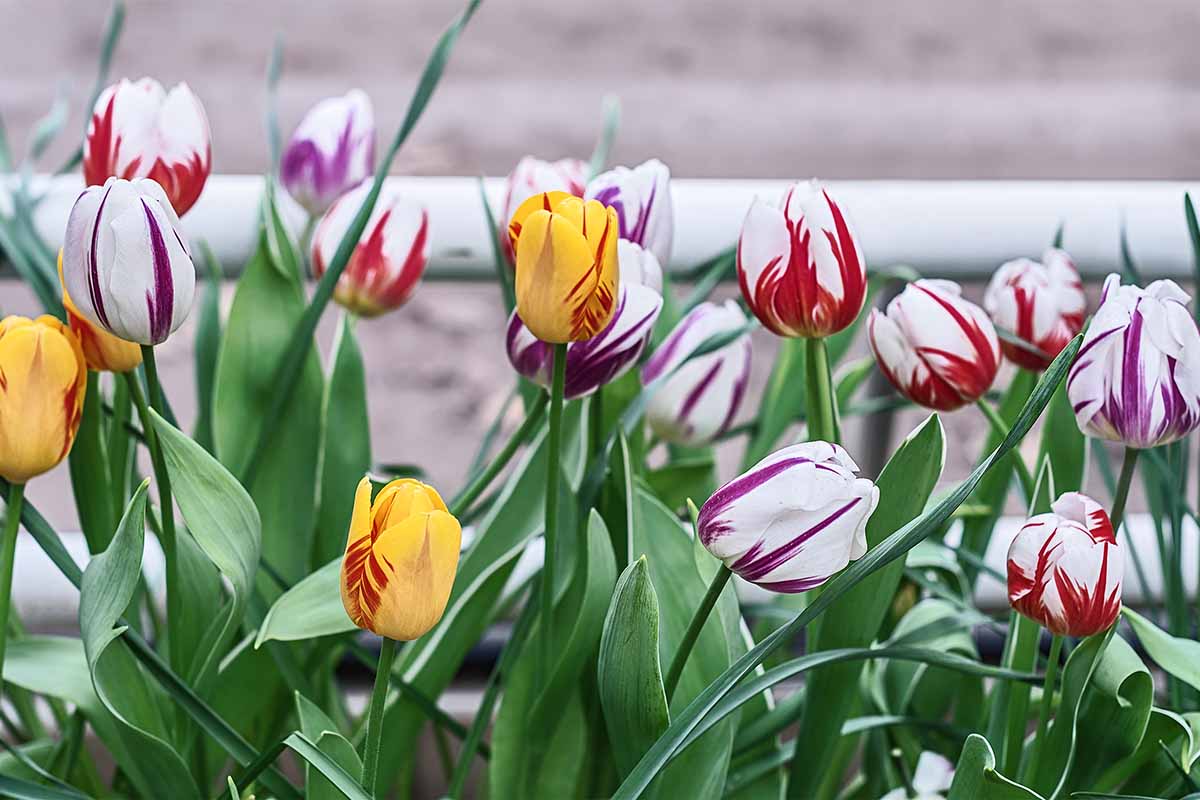
Which improved Rembrandt do you plan to grow? Or are you going to go for a broken one? Do tell! Share your big plans in the comments.
There’s a lot more to these plants. If you’re looking for more ways to use these flowers in your garden, we have more tulip guides that can help you on your journey:

